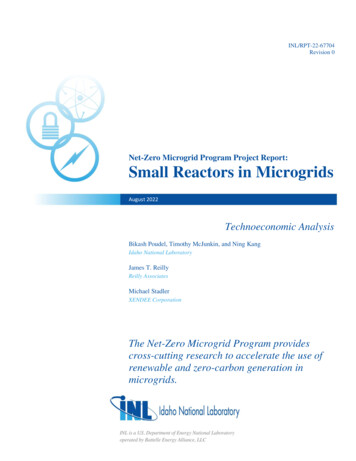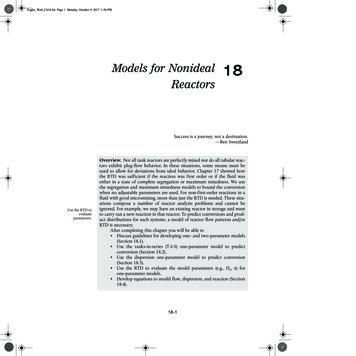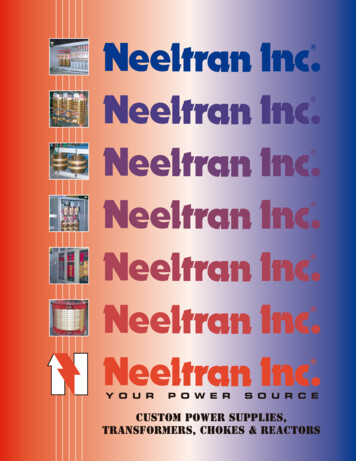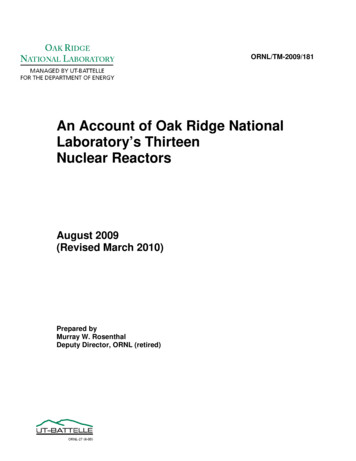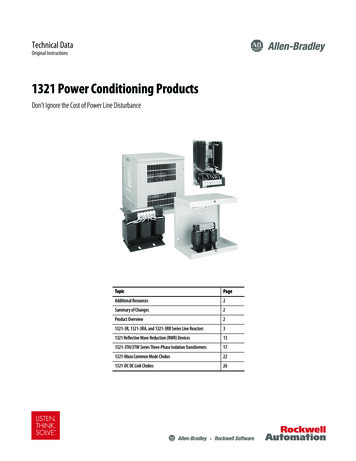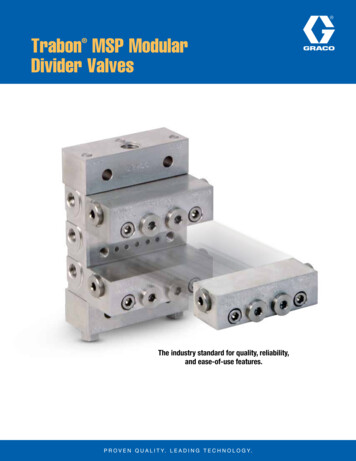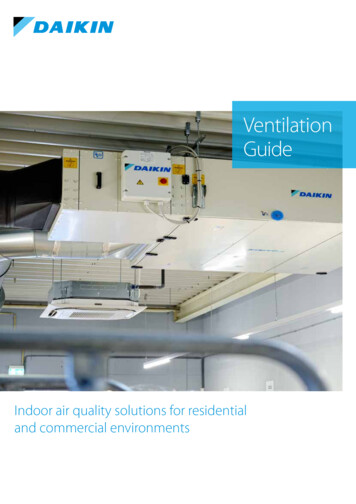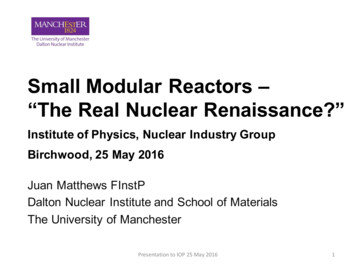
Transcription
Small Modular Reactors –“The Real Nuclear Renaissance?”Institute of Physics, Nuclear Industry GroupBirchwood, 25 May 2016Juan Matthews FInstPDalton Nuclear Institute and School of MaterialsThe University of ManchesterPresentation to IOP 25 May 20161
In the beginning there were just small reactorsGEN IIGEN IIILarge reactorsReactor power (MWe)GEN IMedium reactorsSmall reactorsCompact reactorsPresentation to IOP 25 May 20162
Small reactor marketsThere are are essentially two markets for small reactors:1. Small Modular Reactors (SMRs)–––Sizes from 20 to 300 MWeDesigned for grid connectionNeed to compete with other grid generation2. Very small reactors (compact reactors)––––Sizes from 1 to 20 MWeDesigned mainly for off-grid and isolated generation but could beintegrated into a gridNeed to be easily transportable and installedNeed to compete with diesel and other off-grid generationThe U-Battery is an example of 2, in this presentation we look at 1.Presentation to IOP 25 May 20163
USA interest in SMRs The American interest in the 1980s for SMRs wasdriven by EPRI and the US Department of Energy on astrategic basis, looking at requirements for nuclearpower both domestically and for export. Around 2000 the focus had changed to the need toreplace coal fired power stations in a fragmentedderegulated generation industry. This momentumhas, at least temporarily, been broken by theavailability of cheap shale gas. The US DoE is currently running an SMR TechnicalLicensing Support ProgramPresentation to IOP 25 May 20164
USDOE view of SMR benefits Modularity: in two senses – factory fabrication of modules for asimpler assembly on site and reactor units as modules that can beadded to match demand; Lower Capital Investment: lower unit of investment and lowerinvestment per unit power from factory fabrication and shorterconstruction times; Siting Flexibility: smaller footprint, less demanding infrastructureand possibility of siting on existing fossil sites nearer habitation; Gain Efficiency: use of heat for industry and other applications andcoupling with other generation sources for more efficiency; Non-proliferation: Depending on type of SMR could lead toreduced transport and handling of nuclear materials and longerrefuelling times, possibility of sealed fuel units; International Marketplace: Opens a new nuclear market.Presentation to IOP 25 May 20165
Other potential advantages of SMRs Multiple build enables reduced costs throughlearning; Enables existing licensed sites to be used wherespace is limited; Small reactors can fit into limited electrical grid inremote regions, islands and in developing countries; Small reactors are simpler and more able to usenatural convection and passive safety features and tobe located underground.Presentation to IOP 25 May 20166
UK INTEREST IN SMRSPresentation to IOP 25 May 20167
UK first interest in SMRs UK Interest in SMRs dates back to the late 1980swhen it was realised that the privatisation of theelectricity supply industry would make the investmentin large reactors difficult. Studies at that time looked at the effect of scale oncost and the industry was still firmly looking at largereactors. The UK (Rolls Royce and AEA Technology) joined theSIR project (Safe Integral Reactor) with ABB andStone & Webster, but in the end the dash for gas won.Presentation to IOP 25 May 20168
UK current interest in SMRs UK Nuclear Industrial Strategy, March 2013: “To be a keypartner of choice in commercialising Generation III , IV andSmall Modular Reactor (SMR) technologies worldwide”. NIRAB (Nuclear Innovation and Research Advisory Board)initiated a feasibility study with BIS support in 2014. The feasibility study was published in December 2014 by theNational Nuclear Laboratory and focussed on the integralPWR design. In May 2015, DECC commissioned an in-depth TechnoEconomic Assessment, which has just reported. This covers:the economic case; grid integration, market assessment andfuture trends; safety and manufacturing.Presentation to IOP 25 May 20169
UK current interest in SMRs A report by the Energy Technologies Institute published inOctober 2015 looks at SMR siting and identifies SMRs as asolution to the shortage of new nuclear sites and the lack of alow carbon solution to energy for heating. The Government Spending Review in November 2015,specifically mentioned small modular reactors in the contextof 250 million increased funding for nuclear. The 2016 Budget also mentioned small modular reactors. The Government is now moving to assess designs and leadcompanies to decide if is will support an SMR project. A 30 million “Phase One” of a competition was announcedon 17 March 2016 and bids had to be in place by 6 May. Aroadmap will be published in September 2016.Presentation to IOP 25 May 201610
What is the UK looking for SMRs present an opportunity for the UK to have a stake in thedevelopment of a system that may lead eventually toinvolvement in GEN IV reactor construction and to be globalnuclear player again. The hope is to find a project partner that will make space forUK participation and IP generation – perhaps on the model ofhow aircraft are built. There are currently too many SMRs designs. Inevitably mostwill fail but the winners could eventually pick up 100s oforders. The trick is to pick the winner. The number of sites suitable for large reactors is limited andSMRs are an opportunity to use smaller sites, often nearercentres of population, to expand nuclear capacity.Presentation to IOP 25 May 201611
Potential market for SMRsSource: NNL SMR feasibility study 2014The more recent ETI study suggests this may be an underestimate as theestimate up to 21 GWe for the UK by 2050 worth 60 billion.Presentation to IOP 25 May 201612
Energy Technologies Institute StudySmall Modular Reactors – UK Energy System RequirementsFor Cogeneration (October 2015) Need for nuclear power to contribute to heat supply aswell as electricity generation Need for more flexible generation - load following Need to use sites too small for GWe stations Need to remove dependence on cooling water Need to site smaller stations closer to conurbations toallow the use of heat for industry and homes Potential to use over 20 GWe of SMR capacity by 2040!Presentation to IOP 25 May 201613
Current and historic thermalpower station locations inEngland and WalesFrom “Power plant siting study”August 2015, prepared for the ETIby Atkins.Presentation to IOP 25 May 201614
WHAT SMR DESIGNS ARE WECONSIDERING?Presentation to IOP 25 May 201615
Range of SMR concepts In addition to small versions of current reactors, there are over 60 SMRconcepts that have been studied in the last 10 years but few are likely to bebuilt.The main thrust of recent SMR development is with Integral PWRs – PWRswhere the steam generator is integrated into the reactor pressure vessel(RPV). We will focus on this direction as several designs are close to marketHigh temperature gas cooled reactors are inherently small reactors toenable heat removal in loss of coolant accidents. We have the UK U-Batteryvery small reactor project and China is building a twin 105 MWe pebble bedreactor station.A number of small sodium and lead alloy cooled fast reactor designs –at one time looked like they might be built but currently are seen as a steptoo far for SMR development.There is a recent interest in molten salt reactors, which would be in theSMR range.Presentation to IOP 25 May 201616
The basic components of a PWRPrimarycircuitSecondary circuitCoreTo coastal, riveror cooling towerheat sinkPrimarypumpPresentation to IOP 25 May 201617USNRCSource
Integral PWR(origin marine reactors - Otto Hahn, ondarycircuitSecondarypumpPresentation to IOP 25 May 2016Apologies to USNRC for merging theirPWR and BWR animated GIFs 18
Integral PWR conceptsPowerMWthRPV size (m)Diameter HeightMWeCore size (m)Diameter HeightPrimarycircuitSIR (UK, USA)10003205.819.22.83.6ForcedIRIS (international)10003356.221.32.34.26ForcedCAREM (Argentina)100253.2111.11.4NaturalACP-100* (China)3101003.19101.852.15ForcedSMART (S Korea)3301006.518.51.852.0ForcedmPower (USA)5301804272.02.4ForcedNuScale (USA)160502.917.41.52.0NaturalWestinghouse SMR8002253.7282.32.4ForcedSMR 160** (USA)5251602.7151.643.7NaturalIMR (MHI) 65ForcedRITM 200* (Russia)*External pressuriser **Steam generators and pressurizer section of RPV offset with a dog-legPresentation to IOP 25 May 201619
Advantages of the integral PWR conceptCareful design will give a considerable reduction in the NSSS costbut the main advantages are related to the safety of the system The primary circuit is kept entirely within the RPV, so noprimary pipework and no active circuit outside RPV No penetrations of the RPV larger than 50 mm diameter so nolarge break loss of coolant accidents Increased shielding of RPV from fast neutrons Lower core power density and larger volume of water in RPV Larger surface area to power ratio, making passive decay heatremoval easier Uses standard PWR fuel, but with shorter fuel rods.Presentation to IOP 25 May 201620
Safe Integral Reactor (SIR)Power – 300 MWePower density – 55 MW/m3(similar to BWR)Special design features – 12 modularsteam generators, integral with RPVThere is an extremely low fastneutron dose to the reactor pressurevessel because of the large water gapbetween the reactor core and thevessel wall.Vessel diameter – 5.8 mVessel height – 19.2 mSource: Matzie et al, Nucl. Eng. and Design 136 (1992) 73Presentation to IOP 25 May 201621
PrimarypumpsPressurizer CRDMSteamgenerators8 helicaloncethroughmodulesSource: IAEA Core IRIS (International Secure and Innovative) was acollaboration led by Westinghouse that includedBNFL in the UK and organisations in Italy, Spain,Russia, Brazil and Japan.The main design work was done in the early2000s, but the influence of the project can beseen in all current integral PWR designs.The design is just outside the normal definition ofan SMR at 335 MWe.IRIS has the features that can be seen in designslike the Westinghouse SMR, mPower, SMART,CAREM and some Russian designsIRIS is clearly influenced by the SIR design(Westinghouse acquired ABB CombustionEngineering) but the main innovation is thesealed CRDM inside the RPV.Presentation to IOP 25 May 201622
Westinghouse has moved onfrom its role in IRIS to create itsown 225 MWe SMR designClaimed to be derived from theAP1000 design but clearly builton the IRIS experience The design is much longer andthinner than IRIS and a secondflange is added below the steamgenerators to allow easier accessto the core for fuel reloading.The coolant pumps are alsolocated lower. The Westinghouse design is welldeveloped and has advancedalong the USNRC approval butthere are no specific plans tobuild a first plant. Westinghousehave been lobbying the UKGovernment since the 2015Spending Review. Westinghouse Electric CoSource: WestinghousePresentation to IOP 25 May 201623
Generation mPower LLCSource: Generation mPower LLCThe mPower design comes from B&W in the USAand was being developed as a JV with Bechtel. Itis said to be based on its experience with USnaval reactors, but the influence of IRIS is obviousThe design has been rated at various powers butcurrently aims to deliver 180530MWe. In manyrespects the design is very similar180 to that ofWestinghouse but the coolant pumps are stilllocated at the top of the RPV.The containment concept is less ambitious thanWestinghouse, NuScale Discussionor ACP-1000,with aon construction onlarger dry containment.the TVA Clinch River Site. Plan to submitAfter a veryDesignbullishCertificationstart, severalUS DoEtograntsapplicationthe NRCand substantialinvestmentby B&W,by late-2014for approvalby the2018projectsis now essentially mothballed. B&W are lookingfor a partner to take a majority stake, but stillhopes to be the main manufacturer.Presentation to IOP 25 May 201624
NuScale Power LLCSource: NuScale NuScale started as a concept at of Oregon StateUniversity and Idaho National Laboratory but is nowbeing developed by Fluor. From the point of view ofcontainment and heat removal it is the mostinnovative of the new designs. As the only design the UK is looking at, that usesnatural convection during normal operation, thereactor power is just 50 MWe. It is intended to beused in blocks of up to 12 modules (a total of only600 MWe). Despite this an overnight cost of only 5000/kWe is claimed The CRDM system is external using conventionaltechnology, which means the linkages are very long.2016 in its US DoE Rolls Royce has given support to NuScalefunding applications. Currently the plans are to buildthe first plant at Idaho and it is expected that theconstruction and operation licence application toUSNRC will be made in 2017, NuScale are lobbyingthe UK Government since the 2015 Spending Review.Presentation to IOP 25 May 201625
ACP-100 and ACP-100 (CNNC, China)Pressurizer CRDMSteamgeneratorsPrimarypumps Core ACP-100 Source: CNNCThe Integral PWR project closest toimplementation is the the ChineseACP-100 design which is currentlybeing assessed for safety by the IAEAand construction is waiting CentralCommittee approval.The design for a 100 MWe reactor isbeing replaced with a 120 MWedevelopment with several importantdesign improvements, notably placingthe CRDM and pressurizer inside theRPV.The new reactor is designated for thetime being as ACP 100 and this designis the one that the UK is looking at apossible development partnership.Presentation to IOP 25 May 201626
SIZE MATTERSPresentation to IOP 25 May 201627
Effect of economies of scale on reactor sizeSource: Locatelli et al, Prog. in Nucl. Energy, 73 (2014) 75.Presentation to IOP 25 May 201628
Is reactor construction time related toreactor power?Timeform start of construction to ccommercial operation(years)12Japanese construction times10PWR8BWR64200200400600800100012001400Reactor net power (MWe)Presentation to IOP 25 May 201629
Claimed construction times(from first concrete to grid connection)Main vendor offeringsVVER 1200ATMEARITM 200IMR (MHI)NuScaleSmartAP 1000EPRAPR1400ABWRmPowerWestinghouseSMRDMR (Hitachi)SMR 160Current SMRsconceptsPresentation to IOP 25 May 201630
Variation of reactor vessel diameter with powerPWRIntegral PWRReactor vessel inner diameter (m)SMRs10IRISIMRSIRSMARTACP100CAREMP µr310WestinghouseSMR160NuScaleABV 6M1mPowerRITM 200P µr2100100010000Thermal Power (MW)Presentation to IOP 20 April 201631
Variation of reactor vessel diameter with powerPWRBWRIntegral PWRHTGRLMFBRReactor vessel inner diameter (m)SMRs10Pr3Pr2110100100010000Thermal Power (MW)Presentation to IOP 25 May 201632
Comparison of size of NSSS of an SMR to a regular PWRAP 1000 NSSS net power 1117 MWemPowerNSSSSMARTNSSSNet power 180 MWeNet power 100 MWe27m12m18.5m6.5m OD4m ODSource: IAEA ARIS data and imagesPresentation to IOP 25 May 20164.4m OD33
Comparison of size of primary containment forintegral and regular PWRs.AP1000Westinghouse unit1117 MWe225 MWemPower unit180 MWeNuScale unit45 MWeSource: IAEA ARIS dataPresentation to IOP 25 May 201634
Primary containment of Westinghouse SMR Westinghouse Electric CoSource: WestinghousePresentation to IOP 25 May 201635
ContainmentSMR Containment NuScaleReactor vessel Modules withown containmentin water pond inconcrete cells NuScale Power LLC Source: NuScaleOne of the opportunities for SMR safetydesign is to choose a small-volume pressuresuppression containment more usuallyfound with BWR systems.The NuScale, Westinghouse and ACP-100 designs have below ground tight steel highpressure containments.Westinghouse and NuScale can operate withthe containment under vacuum, so that thereactor has no insulation and is easier tocool by flooding the containment in a loss ofcooling accident.The Westinghouse and ACP-100 containments have internal water reservoirsfor pressure suppression.The NuScale design has up to 12 reactorssitting in a large fuel handling pool.Presentation to IOP 25 May 201636
Footprint of SMRs – are they smaller?ReactorNuclear island aream2Nuclear and nonnuclear Island aream2/MWeCurrent designs relevant to UK 10000EPR 5000AP1000 3250ABWRm2Total aream2/MWeHectaresm2/MWe6 2500015Twin 170 5004.5 100009Twin 125 5602.5 75005.5Twin 50 185 12257 367520Twin16 450 11245 450020Single 6.5 290 145832 6561146 360036 7200 130012.5 3000SMR designsmPowerWestinghouse SMRNuScaleSMARTHTR-PMx1218 33372Single 9 90029Twin 2 100SMRs occupy less land in absolute terms but are comparable relativelyPresentation to IOP 25 May 201637
WHAT ARE THE SMR CHALLENGESFOR THE UK?Presentation to IOP 25 May 201638
Overnight costs of US nuclear plantRange ofUS SMRclaimsAP 1000US EIS dataPresentation to IOP 25 May 201639
/kWeSMR overnight capital cost estimatesData from “SMR feasibility study”, National Nuclear Laboratory, December 2014The study had access to 4 of the best developed SMR design, the “adjusted” datais where the original vendor data was reassessed by the study team.Presentation to IOP 25 May 201640
SMR levelised electricity cost estimatesLevelised cost estimates are shown for discount rates of 5%, 8% and 10% for FY 2012 sData from “SMR feasibility study”, National Nuclear Laboratory, December 2014Presentation to IOP 25 May 201641
Importance of reducing manufacturing costs An Energy TechnologiesInstitute study hasshow that overturningthe economies of scalefor SMR is vital to theirviability.The use of factoryproduction to reducecosts might be a way ofgetting substantial costreduction withproduction of manyunits.The use of residual heatfor district heat makesthe viability of SMRmuch more attainable.Cost model projections and breakeven capex levels forelectricity only generic SMRsFrom “The role of nuclear in a low carbon energy system” andEnergy Technologies Institute Insight Report October 2015.Presentation to IOP 25 May 201642
ETI study on cost reduction250200150100500(Weighted averagecapital cost)From: “System requirements for alternative nuclear technologies”Mott MacDonald Report the Energy Technologies Institute, August 2015.Presentation to IOP 25 May 201643
What can we conclude about SMR costs? SMRs should be built in substantially shorter times thanlarger reactors SMRs will occupy much less land than larger reactors butthe area occupied/kWe is not very different. Overnight costs/kWe of SMRs are similar to those oflarger reactors. Levelised costs of electricity from SMRs may be smallerthan from larger stations, but there is a large uncertaintywhich can only be resolved when an SMR buildingprogram is started. The unit cost of capital for a twin SMR station is still largefor a deregulated electricity industry at around 2 billion.Presentation to IOP 25 May 201644
Manufacturing issues The only way the overnight costs for SMRs cancompete with larger reactors is to have simplecompletely modular designs that can be madeefficiently in factory conditions and quicklyassembled on site. If SMRs are successful then the number of systemsbuilt could be hundreds and experience from theaircraft and automotive industry might be useful. It would then be worth making the investment intooling for automated fabricationPresentation to IOP 25 May 201645
Modular construction Modular construction should extend to the whole plant. Experience from the aircraft industry shows that complexmodules, weighing 100 tonnes containing multiple servicescan be made by different factories and assembled on site, butit needs precision.A380 Module Source: AirbusPresentation to IOP 25 May 201646
Modular construction for whole plant Replacement of shuttering and rebar setting withstructural modules for shield walls and main plantstructures. Modules are filled with concrete once inplace. Structural modules with built-in piping , cable trays,ductwork, HI-VAC and other services. Functional modules that contain a plant systems, egwater treatment. Modules need to be small enough to be transportableand where possible they should be interchangeable.Presentation to IOP 25 May 201647
SMR R&D needs Integral PWRs mostly use the same technology asother LWRs and the same fuel, reduced in length. Sothe materials, fuel and structural integrity issues arethe same ones as being faced in BWRs and PWRs, egZr alloy oxidation and radiation damage of the RPV. The really distinct issues for SMRs are related to:– specific design features;– safety;– and manufacture. For lower power SMRs there is the possibility ofcassette fuel replacement.Presentation to IOP 25 May 201648
NNUMAN and Nuclear AMRC There are two major activities in the UK at the heart ofadvanced nuclear manufacturing:– The EPSRC New Nuclear Manufacturing program (NNUMAN) which isdoes research at TRL 2-4 with 8 million investment.– An 8000m2 research factory, with 30 million investment, at theNuclear Advanced Manufacturing Research Centre (AMRC)ManufacturingTechnologyResearchLaboratoryThe Universityof ManchesterNuclear AMRCResearchFactoryUniversityof SheffieldPresentation to IOP 25 May 201649
Use of advanced manufacturing technology It has proved very difficult to introduce the latest technologiesinto current new build, because of barriers of licensing ofestablished designs. SMRs offer an opportunity to avoid the barrier, decreasingcosts and manufacturing times, while improving reliability. Technology being developed by NNUMAN and the NuclearAMRC–––––––Electron and laser welding – narrow gap, thick sectionAutomatic welding of complex components – steam generatorsAssisted machining – cryogenic machiningRobotic machining and process to part manufactureDiode laser cladding of primary circuit facing structuresNear net shape and additive manufacture – eg HIPState-of the-art metrology with virtual and augmented realityPresentation to IOP 25 May 201650
Modular structure of the RPVin the mPower and Westinghouse designs.PressurizerSteam generatorUpperflangeMid-flangeSteam outletand feedwaterinletPumpsCRDMCoreWestinghouse SMRmPowerPresentation to IOP 25 May 201651
Main components for themPower NSSS Pressure 14 MPa Max T 320 CMain structural components lowalloy SA-508 Gr. 3 steel withprimary facing surfaces clad in308 stainless steel or alloy 57.Currently large structures arelikely to be forged and machined.Cladding of surfaces is done byoverlay welding. Studies arebeing done on the use of powdermetallurgical methodsSteam generator tubes are Alloy609 or a similar nimonic.The secondary circuit is largelybased on low alloy steel so thereare no transition weldsSource: Sandusky and Lunceford, PNNL-22290 2013Presentation to IOP 25 May 201652
Main components for the mPower core structures Core structures are mainlymade of 304L or 316 nucleargrade stainless steels, butthese have poor radiationresistance, largely through thehigh nickel content. Noalternatives are available yetand this could be a life limitingfeature on components.Components like support gridsare made by machining largeforging with high fractions ofmaterial removal, as weldedstructures may not beacceptable. There areopportunities for newadvanced manufacturingmethodsSource: Sandusky and Lunceford, PNNL-22290 2013Presentation to IOP 25 May 201653
Main components for theNuScale NSSS andprimary containmentDifferences from the mPower designinclude: No recirculating pumps as thesystem uses natural convection; Control rod drive mechanism(CRDM) is external so the topdome has many penetrations andthe control rod extensions arevery long The steam generatorconfiguration is the opposite ofmPower – the secondary circuitpasses through the boiler tubes. The primary containment is asteel vessel fitted tightly aroundthe reactor vessel.Source: Sandusky and Lunceford, PNNL-22290 2013Presentation to IOP 25 May 201654
Design issues Primary coolant pump– The primary pumps are usually fixed externally in a “canned design” witha penetration through the RPV for the drive to the impellors. Some designsdispense with pumps and operate wholly on natural convection. Control rod drive mechanism (CRDM)– The long RPV and the location of steam generators and pressurizer makesdesign of the CRDM difficult. Some designs use a sealed internal CRDM. Steam generator– The steam generators have to be compact and efficient. Many systems usemodular steam generators that can be isolated and separately removed ifthere is a tube leak. Pressurizer– The location and small volume available for the pressurizer is a challenge.Presentation to IOP 25 May 201655
Westinghouse SMR CRDM“The CRDMs are a high-temperature andpressure version of the recently developedAP1000 CRDM, which has already beentested to eight million steps, to be usedwithin the pressure boundary of the SMRintegral reactor. Elimination of control rodpenetrations through the reactor pressureboundary has resulted in reduced cost ofmanufacture and the elimination of thenormally-postulated rod ejection event.”Source: Nuclear Engineering InternationalPresentation to IOP 25 May 201656
Safety issues Smaller reactors are easier to cool passively Some designs are very conventional in theirapproach to safety systems, but others, notablyNuScale, take the opportunity to completely rethinkheat transfer in accidents. The use of tight low volume containments. Sitting the containment in a large volume fuelhandling water pool. The use of multiple cooling routes and with lowpower cores the possibility of dry cooling by airconvection without the melting of the reactor.Presentation to IOP 25 May 201657
NuScale safety featuresIn operation there is a vacuumbetween the containmentvessel and the RPV. There is noneed for insulation on the RPVmaking inspection easier. NuScale Power LLCDecay heat removal fromexternal feed wateraccumulators and from mainwater pool. Steam generatorsare used to cool primary circuit.Presentation to IOP 25 May 2016Emergency core cooling bypassive convective cooling byflooding containment vessel.Any primary circuit steam isvented through reactor ventvalves58Source: NuScale Power LLC
Long term cooling in NuScale NuScale Power LLCPresentation to IOP 25 May 201659
THAT ALL FOLKS!juan.matthews@manchester.ac.ukPresentation to IOP 25 May 201660
A report by the Energy Technologies Institute published in October 2015 looks at SMR siting and identifies SMRs as a solution to the shortage of new nuclear sites and the lack of a low carbon solution to energy for heating. The Government Spending Review in November 2015, specifically mentioned small modular reactors in the context



